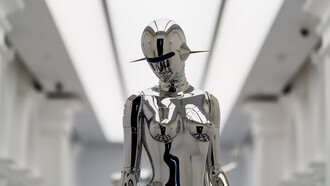In truth the full name of this great character is Valerie Jane Morris-Goodall. She was a skinny, pale, blond-haired girl. No one would have expected that such a slender and shy person would later emerge one of the most prestigious and well-known women around the world for her research and activities in the defense of nature and advocate of conservation. This was not her destiny but the result of an undisputed stubbornness and resolution in the choices of the young Jane and a strong personality which hid behind such a slender profile. The charm of this great woman was, and still is, that no one would have expected the results that gave her so much notoriety and important awards: in 1990 the Kyoto Prize for Basic Sciences, in 2002 the Prize awarded to her by Kofi Annan as Messenger of Peace of the United Nations and not least, in 2010 in Italy the Golden Dove Prize awarded to her by the Nobel Prize Rita Levi-Montalcini.
In addition to all these merits Jane Goodall had a truly revolutionary one, given the times when she began researching at Gombe Stream National Park in Tanzania at the age of 26, she was the first to assign not numbers as was done until then to animals, in this case to her chimpanzees, but to people's names such as Dick, David, Charlie, Pom and Prof. In the eyes of someone who does not do the work of a primatologist or an animal psychologist, this may seem secondary, but really it is not at all, as naming animals means assigning them a personality, individuality and above all animal dignity. This was the first step to begin demolishing that human mentality of always considering themselves at the center of the world with which it can do and justify anything. With Jane Goodall, anthropocentric security begins to falter and that in effect is, and has been, the main cause of all our evils: pollution, economic disparities, pandemics, wars and overpowering. Jane Goodall is, and will always remain, a peaceful revolutionary in this sense, as it is in her character.
But it is not Jane Goodall's personal life that I want to talk about in this tribute, there are many biographies about her that can be read in magazines, books, interviews and articles. Her private life and personal history shaped her and had a profound impact on her choices and above all her determination and commitment to her cause. Her colleagues' presence in African forests is often fragmentary and occasional, while Jane Goodall has spent nearly thirty years in permanent contact with her animals, the chimpanzees (Pan troglodytes). In all my books and in different scientific articles I have always mentioned her works. I have always considered them fundamental to a scholar of animal behavior and psychology.
Jane Goodall has always maintained during her work that a fair balance must be found between the needs of man and the conservation of animals, including her beloved chimpanzees. Unfortunately, there is no such balance. Forests are being destroyed in order to make room for cultivation to support local families. The natural environment around Gombe Stream National Park is getting worse day by day and right under her nose. Farmers cut down trees, even centuries old ones, to make room for agriculture, mistakenly thinking that those lands torn from the forest are very fertile, even if in reality this is not the case. But the most serious damage of deforestation is caused not only by farmers, but by wood multinationals that, in order to obtain valuable wood, not only cut and destroy forests, but build roads and ports along Lake Tanganyika for its transport. These for-profit natural disasters are common in many African and Asian countries, especially Indonesia and Malaysia.
Returning to Tanzania, in the face of this disaster, Jane Goodall has long since started to move on the diplomatic side by interacting with the local authorities, also trying to convince the population that environmental protection is very important, not only for the conservation of animals and chimpanzees, but for future generations to whom there will be nothing left in a few decades' time: there will be no land to cultivate, nor other resources that until now have helped people to live.
In 1994 Jane Goodall set up an organization named TACARE (Tanganyika Catchment Reforestation Education) and then ROOTS and SHOOTS (a program of humanitarian and environmental education for young people), both aimed at promoting sustainable agriculture; two projects that in any case had to be managed by the local population, not by the bureaucrats of Dar-es-Salaam, the capital of Tanzania, nor by services unrelated to local realities. While Jane Goodall has done an admirable job raising awareness it is a never-ending effort. There have been, and still are, few scientists who, in addition to their research efforts, promote projects for the protection of nature. Jane Goodall to help these promotions has written popular books, especially for children and she has given television and journalistic interviews.
We Europeans do not think about it, but if we ask African children, especially those who live in cities, if they have ever seen elephants, the answers are mainly negative and those who have seen them is in zoos and if you ask them if they have ever seen chimpanzees, surprisingly you do not get any affirmative answers, yet chimpanzees live in Africa not Scandinavia. This should make us reflect on how and where the world is going. The same children to whom we would have asked these questions would often have replied that, however, they had often seen dead, eviscerated and dried monkeys on the market stalls. In Africa monkeys are killed out of necessity, not because they are a delicacy. In the face of this Jane Goodall never got discouraged. She has continued to involve states and various institutions for conservation.
Jane Goodall did not just move in that direction. As people know, monkeys are kept in different laboratories around the world for experimentation. Often visiting some she was shocked to tears because of the poor conditions in which monkeys were imprisoned, even chimpanzees. She tried to raise awareness among staff to offer better conditions to these animals.
Jane Goodall has never given up (any other person would have given up a long time ago) and has continued her battle. She has never thought about letting go despite no longer being the young girl who studied chimpanzees decades ago at Gombe Stream National Park.
One day, a reporter for The Wall Street Journal asked her two questions to which Jane Goodall answered in a truly surprising way and that reflected her character and her commitment to defending nature. Firstly, she said that we men until we know nature deeply, we could never protect it, so it is important that children begin to know it as soon as possible. The second answer was even more emblematic in the sense that she said that it is the parents who should encourage their children the most, from an early age, to explore the world of nature even starting from their garden, as she did as a child in her family home called "The Birches" in Bournemouth, England, always in the company of her toy chimpanzee named “Jubilee” given to her by her father on her first birthday.
There is another very recent fact that worries Jane Goodall and that is the spread of the Covid-19 pandemic, namely the possibility that this virus could spread among chimpanzees. The consequences of infection could be profoundly serious given the similarity between these animals and man with whom they share about 99% of their genetic heritage. The anatomy and immune system of chimpanzees are practically the same as the human ones. So far, no evidence has been found of infected chimpanzees, but there is concern that this may happen and endanger their existence. Unfortunately, chimpanzees have not just this danger, but there are many others that are as dangerous as cutting down the forests in which they have always lived, mining extractions, especially of gold, diamonds and coltan (a natural mixture of two minerals, tantalite and colombite, indispensable for the construction of the electronic components of our smartphones), disproportionate growth of the local human population, poaching and the market for their meat for the purpose of food. With regard to Covid-19, Jane Goodall added another serious threat represented by a part of the world population that underestimates its danger and does not listen to the opinion of scientists who try to warn us.
In conclusion, I wanted to address this brief tribute to this great character, not only for her popularity and research work in the field, but also for other personal reasons. The most important was that reading her works, especially the first she published in 1970, entitled My friends the wild chimpanzees, in The National Geographic Magazine. This article fascinated and inspired me to write, many years ago, when she was working at Gombe Stream National Park and I was still a biology student writing my first University thesis. The second reason is that one has always maintained that to carry out research in full knowledge you need great masters and mentors. Hers were, at least I think, the eminent paleontologist Louis Leakey and Robert Hinde. The latter, by the way, was also the chairmen of her thesis for her doctorate that I was lucky enough to read during the period I attended at the Sub-Department of Animal Behaviour of the University of Cambridge, in whose library are all the theses of students who graduated with Robert Hinde. I have never had the strength and determination of Jane Goodall but in my life and in research I have had mentors some of whom, perhaps, without knowing that they have been masters for me. I would like to mention at least four of them that I have met, both for short and long periods of time, of which I still keep a very dear and moving memory: Billy Mason in Davis, California, Robert Hinde in Cambridge, Paolo Moderato and Marcello Cesa-Bianchi in Milan.
I would like to end with an emblematic phrase that Jane Goodall gave in an interview to The Wall Street Journal on July 11th, 2020:
I was put in this world to do what I am doing.
Thanks a lot Jane and Happy Birthday.
Recommended readings
Goodall, J., 2010. Through a window: My thirty years with the Chimpanzees of Gombe. Boston. Mariner Books.
Goodall, J., 2015. Seeds of hope: Wisdom and wonder from the world of plants. New York, Grand Central Publishing.
Sánchez Vegara, M.I., 2019. Pequeña & Grande Jane Goodall. Barcelona, Alba Editorial s.l.u.
Greene, M., 2005. Jane Goodall. A biography. Westport, CT (USA), Greenwood Press.















